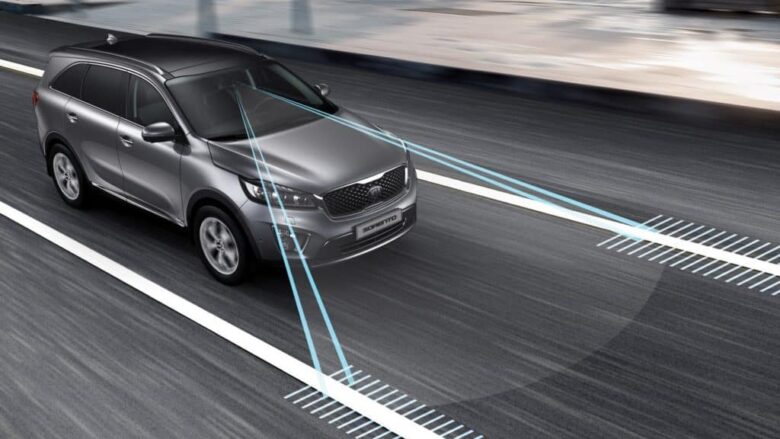In the modern automotive environment, advanced safety features are no longer just optional extras; they are fundamental components of today’s vehicle design. These features are designed to protect pedestrians, drivers, and passengers, making roads safer for everyone. As technology advances, automakers are integrating more and more advanced safety systems into their vehicles. Below are some of the advanced safety features you should be aware of and how they can help create a risk-free driving experience.
1. Automatic Emergency Braking
Automatic Emergency Braking (AEB) is one of the most important safety mechanisms to help stop or reduce the intensity of a collision. The system uses sensors, cameras, or radar to detect potential roadblocks or vehicles in the car’s path. If the system detects an impending collision and the driver does not react in time, AEB can automatically apply the brakes to minimize or avoid the impact. This technology is especially useful when a driver may be distracted or unable to react quickly.
2. Adaptive Cruise Control
An advanced form of traditional cruise control is Adaptive Cruise Control (ACC). Unlike traditional cruise control systems that maintain a constant speed for the driver, ACC adjusts the speed of the car based on the traffic ahead. It uses cameras or radar to track the distance between your car and the vehicle ahead. If the system detects that traffic is slowing down, ACC automatically reduces the speed of the vehicle to maintain a safe following distance. Once the traffic clears, the system returns to the pre-selected speed. This feature increases convenience and safety, especially during long journeys and traffic jams.
3. Monitor Blind Spots
Blind Spot Monitoring (BSM) is a useful safety tool that allows drivers to be aware of vehicles in their blind spots. BSM detects vehicles in the driver’s blind spot and alerts them via sensors or cameras on either side of the car, via side mirrors or visual indicators in the cabin. Some systems also sound an audible warning if the driver attempts to change lanes and detects a vehicle in the blind spot. This feature is especially helpful in preventing side collisions when changing lanes.
4. Rear Cross Traffic Alert
Rear Cross Traffic Alert (RCTA) is a safety feature designed to help drivers back out of a parking space. RCTA uses cameras or sensors to monitor approaching traffic in the area behind a car. If the system detects a car approaching from either side while the driver is backing up, the driver will receive a visual or audible warning. This feature helps prevent accidents in busy driveways or parking lots where visibility may be limited.
5. Forward Collision Warning
An advanced safety feature called Forward Collision Warning (FCW) uses cameras or sensors to monitor the road ahead for potential collisions. If the system detects a risk of a frontal collision with a vehicle or object, the system will warn the driver. Typically, this warning is a visual, audible, or even tactile feedback from the seat or steering wheel. FCW is designed to provide drivers with important tips so they can take action before a collision occurs.
6. Electronic Stability Control and Traction Control
Systems that help maintain vehicle stability and control under varying driving conditions include Traction Control (TC) and Electronic Stability Control (ESC). Traction control reduces engine power or applies the brakes to spinning wheels to prevent wheelspin during acceleration. This is especially useful in slippery conditions such as rain or snow. Electronic Stability Control selectively applies the brakes to individual wheels and varies engine power when it senses the vehicle is losing traction, designed to prevent skidding or loss of control. Together, these systems improve the overall stability of the vehicle and help the driver maintain control under demanding driving conditions.
7. Adaptive Headlight Design
Adaptive headlights are advanced lighting systems designed to improve visibility while driving at night. Unlike traditional headlights, which have a fixed beam pattern, adaptive headlights can turn and change angles based on vehicle speed, steering angle, and road conditions. This allows the Headliner to better illuminate the road ahead, especially around curves. By illuminating the road better, adaptive headlights help improve night-time driving safety and reduce the risk of accidents.
8. Driver Attention Monitoring
Driver Attention Monitoring is designed to assess the driver’s level of awareness and provide a warning if drowsiness or distraction is detected. To measure driver attention, the system combines multiple data, including lane behavior, vehicle speed, and steering pattern. If the system detects that the driver is becoming tired or distracted, it can send a visual or audible signal or recommend a break. This feature is designed to prevent mistakes caused by driver fatigue and encourage better driving habits.
Conclusion
The development of modern vehicle safety features marks a major shift in automotive technology to protect drivers, passengers, and pedestrians equally. From autonomous emergency braking and adaptive cruise control to blind spot monitoring and driver attention monitoring, these technologies are designed to improve vehicle safety and reduce the chance of a collision. As technology advances, more advanced safety systems should become standard on vehicles, creating safer roads and a more comfortable driving experience.
FAQs
1. What is Automatic Emergency Braking (AEB)?
Automatic Emergency Braking (AEB) is a safety enhancement designed to automatically apply the brakes to avoid or mitigate a collision. It can use sensors, cameras, or radar to identify objects or vehicles in the car’s path and apply the brakes if a potential collision is imminent and the driver does not react in time.
2. How does Adaptive Cruise Control (ACC) work?
Like traditional cruise control, Adaptive Cruise Control (ACC) maintains a set speed but also adjusts the vehicle’s speed based on the distance to the vehicle ahead. ACC uses radar or cameras to monitor traffic and then automatically slows down or accelerates to maintain a safe following distance.
3. How is Lane Keep Assist (LKA) different from Lane Departure Warning (LDW)?
Lane Departure Warning (LDW) typically uses a visual or audible warning to alert the driver when the vehicle has unintentionally left its lane without signaling. In addition to alerting the driver, Lane Keeping Assist (LKA) actively guides the vehicle back into its lane using steering input.
4. What are the benefits of Blind Spot Monitoring (BSM) for drivers?
Blind Spot Monitoring (BSM) uses visual signals in the side mirrors or in the cabin to alert the driver to vehicles that are detected in the driver’s blind spot. The system helps prevent side collisions by alerting the driver to vehicles that may not be visible when changing lanes.
5. How does the Rear Cross Traffic Alert (RCTA) system work?
Rear Cross Traffic Alert (RCTA), which monitors the area behind the vehicle, helps the driver back out of a parking space. If the system detects vehicles approaching from either side, it will provide a visual or audible warning to help avoid collisions in crowded parking lots.




